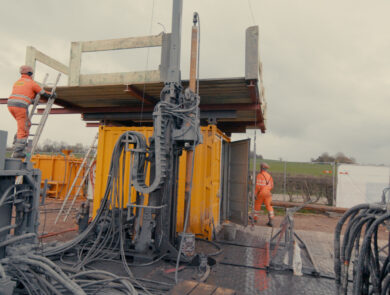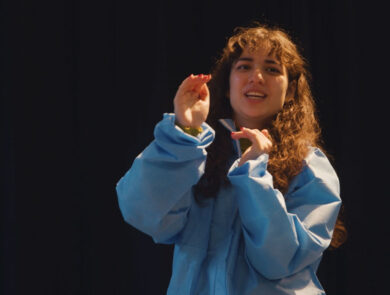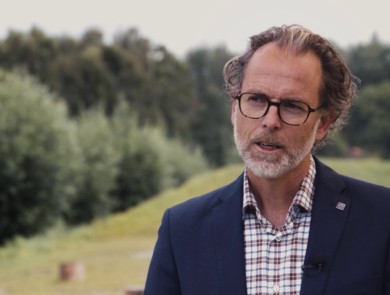Residents in the search area of the Einstein Telescope: ‘Be careful with our landscape’
The 7 information sessions for residents from the search area of the Einstein Telescope have been attended by nearly 600 people in recent weeks. Residents from Welkenraedt, Aubel, Plombières, Dalhem, Voeren, Gulpen-Wittem, Vaals, and Eijsden-Margraten were interested in numerous aspects. They not only had many questions but also one important message: be very careful with our beautiful landscape.
Thematic tables
The format of the evenings consisted of a presentation about the Einstein Telescope, the feasibility study that the Einstein Telescope project office will be working on for the next 2 years, and the 11 test drillings that will be carried out in the coming six months. Afterwards, visitors could join one of the thematic tables with questions, their vision on the Einstein Telescope, and tips or advice for the project office. (See also ‘the most mentioned questions and advice’ at the bottom of this report). Overall, a lot of enthusiasm was recorded, but at the same time, there are also many questions. This led to engaging conversations at all the thematic tables.

Feasibility phase
Employees of the Einstein Telescope EMR project office made it clear that the project office will definitely need the next 2 years to demonstrate the feasibility of the Einstein Telescope in this region. This also means that many logical questions still have no concrete answers.
Examining feasibility goes much further than just researching the geological composition and suitability of the soil. The water management in the region, and particularly the impact of the construction phase, are also topics that residents showed great interest in. For example, how to move and give a sustainable destination to the – according to current estimates – 4 million cubic meters of soil. How large will the underground corner points be? Are above-ground buildings necessary, and how will they be integrated into the landscape? Or what effect the Einstein Telescope will have on the availability of energy supply or on the availability of housing in the region and its price development.
Especially in the Walloon part of the search area, residents explicitly raised the question to what extent the arrival of the Einstein Telescope can prevent the reopening of mining. The logistical study on the possible use of the railway yard in Montzen mainly led to the call during the meeting in Montzen to clarify as soon as possible what this means concretely for this place.

Job engine and local economy
It is nice that the Einstein Telescope creates many jobs at all levels, but a recurring question was where those expected jobs will exactly end up. Are those in the university cities in the Euregion Meuse-Rhine or also in the places where the telescope will be built?
At the thematic tables ‘economy/valorisation’, much was discussed about the possibilities and opportunities for local entrepreneurs during the construction phase and during the years of operation. The examples of the Interreg project ET2SME’s (Einstein Telescope to Small and Medium Enterprises) were inspiring. Also, the already concrete examples of deliveries by local suppliers such as bakers, carpentry companies, contractors, to B&Bs were mentioned.
During several meetings, recent graduates, students, and students presented themselves with the practical question of when it will be clear exactly which jobs are involved and – anticipating this – where they can report their interest. While discussing this, the suggestion was also made several times to open the Einstein Telescope Education Centre in the Discovery Museum in Kerkrade (NL) to young people from the entire Euregion and to come up with other ways to enthuse young people for the Einstein Telescope.

Municipalities and ownership
The question also arose as to who owns the land being drilled. If it is the municipality, it would be good to also channel the value of the land into the municipal treasury when it is repurposed. Through the municipalities, residents would also directly benefit. But also legally oriented variants came up for discussion, such as ‘Do I, as a homeowner, have a say or am I entitled to compensation when the telescope runs 250 meters deep under my house?’.

Tourism
The underground Einstein Telescope itself cannot become a tourist attraction. Nevertheless, there was much attention for the possible effects on tourism in the region. Where often the fear was mentioned that the Einstein Telescope would cause extra tourism in an already overloaded area, others saw it as an opportunity for areas that are still less developed in terms of tourism.
Science
Many visitors wanted to know more about the scientific side of the Einstein Telescope: why do we actually want to build such a research facility? How can this underground measuring instrument measure a thousand times more gravitational waves than the current detectors? The magic of science captured the imagination of many present.

Message
The project office also received a message: continue to involve residents in all developments surrounding the Einstein Telescope. And in extension: ‘How can we think about the best way to build to limit the nuisance?’ to ‘What legal possibilities and moments are there for residents to try to stop an unwanted step in their eyes?’.
The 7 evenings have yielded a lot of useful information and misunderstandings have been clarified. For the project office Einstein Telescope EMR, there are sufficient suggestions and questions on the table to involve in the follow-up of the communication and later the participation trajectory towards the residents.

Most mentioned questions and advice:
- Ensure that the construction of the Einstein Telescope does not (permanently) disturb the landscape. Anything required above ground should be seamlessly integrated into the existing landscape.
- Minimise disruption during the construction of the Einstein Telescope to an acceptable minimum for residents.
- Keep residents continuously informed about major steps in the feasibility study and decision-making process. Specify how, what about, and when residents can participate or formally submit their objections.
- In what ways does the Einstein Telescope also strengthen the local economy? Ensure fair distribution of benefits and burdens in the search area. Prevent one part of this Euroregion from gaining jobs and local revenue, while another part experiences the nuisances.
- Connect the arrival of the Einstein Telescope with addressing regional issues such as tourism overload, lack of sufficient housing and its price development, or pressure on energy supplies.


